Want to know how to write a winning scholarship essay? If you're reading this post, chances are, you do!
Perhaps one of the most daunting things about applying for scholarships is writing the essays that tend to go with them.
Listen, I get it.
I was in school and applying for scholarships not too long ago, and I totally agree with the fact that essays in general are just not very enjoyable to write.
Despite that, they tend to be one of the most important contributors to scholarship applications, and can definitely determine whether you win the scholarship or you don’t.
So, in this post, I am going to fill you in on all of my top tips for how to write a winning scholarship essay.

Just like you are hopefully doing, planning on doing, or already did, with your college application essays and personal statement, make sure you get started with your scholarship essays as early as possible. Doing so will leave you in a prime position in terms of having time to properly edit and proofread your essay before hitting submit.
This one is important for when you’re applying for scholarships whose essay questions may ask you to discuss one of the company or organization’s values or something else along those lines.
In this case, it would definitely be beneficial to have done your research on the company or organization and make sure you have a strong understanding of what they do, along with what their values and mission are so that you can appropriately tailor your essay to mention those key points.
This tip ties in nicely with #2, because they are both essentially reminding you how important it is to ~read the room~ when you write!
Just as for any essay you would write, it’s crucial to keep your audience in mind and tailor your tone and language appropriately.
Some scholarships are more light-hearted and may encourage you to get creative with your essays, while others may be more “rigid” in their expectations for your essay.
Also, be sure to read all of the directions on the scholarship application; some organizations might specify their expectations for what they want to see in your essay, which makes your life easier because you then have your work cut out for you!
A strong essay requires more than just good ideas, it demands clear structure and thorough revision. Many students find it challenging to organize their thoughts and refine their writing. The service offered by do my essay helps improve structure, clarity, and content quality. With the right support, any written work can become more effective and persuasive.
The best essays are generally the ones that grab your attention from the very beginning and make you want to keep reading.
This is often called a “hook” because you are attempting (and hopefully succeeding) in hooking your reader into your essay. Common examples of hooks for your scholarship essay include starting with a question, an anecdote, a statistic, or even a quote. However, don’t just limit yourself to these - get creative!
This one should be a no-brainer. Before you can actually sit down to write, or even brainstorm, your essay, make sure that you fully understand what the prompt is asking. Then, once you have a strong grasp of the questions that are being posted, you can get brainstorming, formatting your outline in a way that ensures you will answer ALL of the questions or parts of the prompt in their entirety.
Writing a winning scholarship essay is all about being honest about yourself, your experiences and achievements, and your ambitions, while also making sure you are not plagiarizing in any way.
This means that your essay should be original and not “borrowed” from anyone or anywhere on the internet. While it’s good to do your research to get inspiration for writing your essays, be sure to steer clear from copying other people’s essays in any capacity. Not only is it a million times easier to write about things and experiences that are true, but honesty is also always the best policy, so stick with it!
The people reading your scholarship essays are probably reading dozens, if not hundreds of other essays.
So, it’s likely that they aren’t going to be impressed if they come across writing that is all over the place, irrelevant to the topic at hand, or simply unoriginal. This includes “fluffy language” where you aren’t directly answering the question being asked and cliches of any kind. Therefore, be sure to steer clear of these.
The “show, not tell” writing technique is one that every student should be aware of. For those of you who may be unfamiliar with this technique, it is basically saying that you should tell your story through using descriptive words, strong verbs, and any other type of language that basically puts your reader “in the room with you” so that they can see the story from your perspective. If you need more of an explanation on how to "show, not tell", check out this article.
While this is definitely a key tip, keep in mind that some essays, depending on the prompt, might prefer that you answer the question in less of a “telling a story” way and more of a “straightforward and to the point” way. So, back to tip #5, make sure you understand the question or prompt adequately so that you can then determine how you will approach the writing.
Naturally, in order to get to the main point, lesson, or realization that you're trying to get across with your essay, you will likely have to give your reader some backstory on the situation, what happened, and who was involved. However, when doing so, it's crucial to avoid turning your essay into a full-on plot-fest that distracts the reader from the most important parts of the essay, where you answer the questions they have posed.
Additionally, in my own experience with reading scholarship essays, I have come across many in which students spend paragraphs and paragraphs telling the story of their life, only to take a few sentences at the end of the essay to actually answer the question. Your life story (or part of it) might be an interesting one, but if you fail to tie in the plot with the lesson to answer the question, this is almost guaranteed to make any scholarship committee hit the "thank you, next" button.
The last tip I have for writing a winning scholarship essay is to make sure you edit and proofread your essay. If you write drafts first, you can use the fastest AI article writer for quick drafts, which will help you get on the right track. You should aim to edit your essay at least once, if not multiple times, depending on how much time you have to complete it. After all, if you're going through putting in the time and effort to apply for scholarships, be sure to give your essay the attention it deserves by adequately editing and proofreading it after you’ve written it.
After creating a rough outline and writing your initial first draft, you should plan to read through and edit your essay for content, flow, grammar, and spelling.
Pro-tip: when looking for grammar/spelling errors, read your essay backwards, sentence by sentence.
Then, once you have produced a second draft, I recommend having someone else (think: family member, teacher, or friend) also read over your essay. Often times we tend to overlook errors with grammar and even content/structure because we are so used to our style of writing, so having someone else's eyes on it is helpful to gain some external perspective.

Let’s get real for a sec.
Navigating the world of scholarships can be confusing!
Whether you’re a first-time applicant or a seasoned searcher, there are always questions to be asked about everything in the name of scholarships.
While many of our blog posts do make a point to answer many of the most common questions related to scholarships, having a singular informative and regularly updated page to refer back to with all of your scholarship queries can’t hurt!
So, without further ado, keep scrolling to learn all about scholarships!
A scholarship is free money that you can earn or win to put towards paying for your higher education. Money that you win from applying to scholarships is, objectively, the best form of financial aid out there, because it does not need to be repaid, ever (if you come across a scholarship that indicates it does need to be repaid, then you have been tricked, and it’s not legit!).
There are scholarships out there for students pursuing all types of degrees. Some scholarships are open to community college students, others are for students going after four-year undergraduate degrees, and others are created specifically for graduate students.
A merit scholarship is one specific type of scholarship that you can apply for. When we’re talking about scholarships, the term ‘merit’ just means that the scholarship is taking into account your academic profile, achievements and abilities, as opposed to your level of financial need.
Most opportunities fall into one of the following three categories:
The process of searching and applying for scholarships is in some ways very similar to the college application process.
Let’s walk through the steps...
Student loans (another way to pay for college) are VERY different from scholarships, for one reason and one reason only: money that you receive through student loans is money that you borrow, and must repay with interest.
This is in complete contrast with scholarships, which do not need to be repaid ever!
According to the IRS, scholarships are not taxable if you meet both of the following conditions:
On the other hand, scholarships are technically taxable (aka, must be included in your gross income) if the money is used or put towards education-related expenses such as room and board, travel, or optional equipment.
In one of the earlier questions’ answers, I mentioned that if an opportunity claims to be a scholarship but makes any mention of having to pay back the winnings, then it’s not a scholarship - it’s a scam!
That is one of the main indicators of a scholarship scam, but there are a few more that you should be aware of as you embark on your scholarship journey.
A scholarship is MOST LIKELY a scam if it…
In general, if you come across a scholarship that seems promising but something just looks ~off~, don’t be afraid to do some investigating into the opportunity before you take the leap and apply.
A few things to look for that scream “I am in fact a legitimate opportunity!” are:
It’s one thing to apply for scholarships, but winning them is a whole different story. Getting a scholarship means you not only found an opportunity that you’re a good fit for, but you also clearly met/exceeded the minimum requirements and proved to the committee through your submissions that you are deserving of the funds.
At the end of the day, applying ≠ winning. Here are a few ways that you can make yourself a competitive applicant, all of which will hopefully lead to you winning some scholarships:
Earlier on in this post, I outlined the 4 key steps in applying for scholarships. If you missed it, scroll up!
Winning a full-ride scholarship is no walk in the park, with the primary reason being that these scholarships are worth a LOT of money!
To be honest, my advice on how to get a full-ride scholarship is not much different from my advice on how to win any other scholarship. Here are the two exceptions.
Some, but not all, full-ride scholarships have some element of financial need involved. This means that you can be more likely to expect an additional essay question along the lines of “Why do you deserve this scholarship?”. If you come across this prompt, make sure you know the right way to answer it (hint: DON’T start your essay with “I deserve this scholarship because…”).
Second, many full-ride scholarships will require finalists to interview with the scholarship committee before being officially selected or not selected for an award. When you apply for full-ride opportunities, be prepared for the interviews.
While the answer to this question largely depends on the question that is being asked, here are a few general tips for writing winning scholarship essays:
If you’ve been lucky enough to have been chosen for a scholarship, congrats!
Now that you’ve won some money, the last thing on your to-do list (at least, it should be on your to-do list) is to write the organization/committee a thank-you letter.
Plymouth State University offers a great resource featuring templates for such letters. Check it out once you’ve won a scholarship, or even before you’ve won one - after all, we’re all about manifesting success over here!
Here are some blog posts (featuring dozens of the best opportunities) to help get you started:
Happy searching + applying!
PS - Have questions about scholarships that you don’t see answered here? Let me know!

The process of applying to, and more specifically, winning scholarships, is without a doubt an exciting one.
You’ve gone through all the steps to search for private scholarships, write the essays, gather the other required application materials, and apply, and finally, your hard work has paid off - wahoo!
However, before you start jumping for joy, I want to introduce a term that is well-worth being familiar with. That term is scholarship displacement.
In a perfect world, a student should be able to receive scholarships and grants from their institution, and, if or when they win outside private scholarships, those awards can be added or stacked on top of the institutional aid that the student is already receiving.
When a student wins and reports a scholarship, common practice should be for a student's loans and work-study offers to be the first forms of financial aid that get reduced by the institution.
Unfortunately, that’s not always how the cookie crumbles.
Rather than lowering loan and work-study amounts first, certain institutions are instead lowering the amount of a student's scholarship aid, and this is exactly where scholarship displacement comes in.
Scholarship displacement, at its core, is when your receipt of a private scholarship leads to a reduction of other forms of financial aid (specifically, the free money!) that you may be receiving from your college or university.
The vast majority of colleges and universities in the US mandate that students must report information regarding any outside or private scholarships that they win while in school.
While the reporting alone should be okay, what’s NOT okay is when schools take advantage of the private scholarships that a student has won and subsequently lower the amount of money in scholarships that THEY award the student.
Scholarship displacement is an unfair practice because it essentially means that students who have worked hard to apply for and win private scholarships might not even be able to reap the full benefits of winning those awards, since other forms of financial aid that they may have been receiving (specifically, the scholarships) get decreased by the same amount.
This leaves students in the roughly same financial position that they were in before putting in all of the effort to seek out private scholarships.
Currently, only two states in the US have laws banning scholarship displacement: Maryland and New Jersey.
On September 27, 2021, government representatives from New Jersey and Pennsylvania proposed a bill called the Helping Students Plan for College Act of 2021. The goal of this bill is “To require institutions of higher education to notify students of the impact of private scholarships and grants on eligibility for institutional financial aid, and for other purposes.”
As a recent college graduate who is now working in the financial aid space to help connect students with private scholarships, it is of the utmost importance to me that you and your family are transparently equipped with all of the information that you need to know about scholarships in order to make the smartest higher education decisions.
Plus, I have given out thousands of dollars in scholarships since starting Access Scholarships, so of course I want to make sure that if you win my scholarships (or any others you apply for through Access Scholarships) you can actually use them to put towards your tuition without having other scholarships taken away!
While I truly hope that the Helping Students Plan for College Act of 2021 bill does in fact get passed ASAP, in the meantime, you can help protect yourself from scholarship displacement by doing as much research on the topic as possible.
If you’re a high school student in the process of researching or applying to college, call up the financial aid offices of the schools you’re interested in to inquire about their policies in regards to reporting private scholarships. Ask them what the process looks like once you report a private scholarship: specifically, if the money you earn in private scholarships will subsequently reduce the amount of scholarships you might receive through the institution.
If you’re currently enrolled in college, you should still make a point to reach out to your financial aid office to ask similar questions, because ultimately the answers you receive can have a crucial impact on how you proceed in terms of applying to private scholarships.
Sources: Forbes, Wall Street Journal, and Congress.gov
Studying is one of those things that no one really teaches you how to do, yet, as a student, you often (and unfortunately) end up doing a whole lot of it.
Thinking back to my own school years, my study style and preferences certainly changed a lot from high school to college as I learned new techniques, became more comfortable with utilizing study groups, and got a better grasp on how to organize and prioritize things that needed to get done.
By the time I graduated from college, I truly felt that I had my study routine nailed down to a T. While that didn't mean that I aced each and every single class that I took, it did mean that I performed a lot better than I had in my earlier school days where I would get average grades due to mediocre study efforts.
So, since I want you to achieve success in all of the studying (and subsequently, the tests and exams) that you have coming your way, keep reading to learn my top 5 study tips and tricks to becoming a stronger student.
At the beginning of each and every study session, you should sit down and write or type out what you want to accomplish. Your goal should be one that's not too lofty but also one that's not too easy to hit: somewhere right in the middle.
Once I have set a goal for myself on what I'd like to learn or complete, I'll document it on a piece of paper that I keep either taped to my laptop or in my study area. That way, I can always refer back to it and hold myself accountable for what I said I would do.
Personally, I always found it helpful to create two separate goals, one target goal, and one reach goal. The target goal is one that I am confident I can hit. The reach goal is one that I may or may not be able to hit, depending on how the study session is going, how motivated I'm feeling, and how well I feel that I'm grasping the material. The last thing you want is to cram too much into one session and leave feeling like you haven't accomplished anything.
This is one of those study tips that I wish I had learned earlier! In both high school and college, it's not uncommon to get assigned a certain number of chapters or pages to read before the next class. What I used to do was sit down with my textbook and, as I "read", I would take notes on my computer or highlight the bolded terms as I went.
If you're sitting here reading this and wondering what's wrong with this technique, let me explain.
There is a big difference between learning/ internalizing information and simply memorizing some definitions or concepts. When you employ the technique of taking notes as you read information for the first time, there is a pretty high chance that you aren't giving yourself the opportunity to truly understand what you're reading.
Going back to the tip, I find that one of the most helpful ways to make my study sessions productive is to first read through the material without any interruptions. No notes, no highlighter, nothing. Then, once you feel like you have a grasp on what is being explained, you can go back through and take notes (I prefer handwritten because it helps you to process the material on a deeper cognitive level) and continue on with your session.
Every person has their own opinions on how long is a good amount of time to study for in one session. I have friends who will only sit down to study for multiple hours at a time, and I have other friends who take breaks religiously every 25 minutes, following the Pomodoro Technique.
Personally, I have always found it helpful to either study in chunks (of anywhere between 45 minutes to 1 hour) or to study with a specific goal in mind. For example, if I have to read three chapters in my marketing textbook and answer questions for each, I might aim to take a 5-10 minute break after I finish the reading and questions for each chapter.
This way, I am holding myself accountable for getting all of the work done and ensuring that I don't just sit in the library for wayyy too long and end up not finishing what I planned to do.
This is another one of those study tips that you might not realize is important until it's the night before your first midterm and you're trying to cram two months of information into your brain.
Unfortunately, lots of high schools and college curriculums are set up to encourage you to cover a lot of content in a short period of time. This often means that you will rarely have any designated time between chapters or units to go over the things that you don't understand or have trouble with, which can lead to less than positive situations when you sit down for your exams.
So, when you're studying, try to make it an activity that not only looks forward to the material you have yet to cover, but also makes sure you're taking the time to go back to study and relearn previous units and concepts that you struggled with. By giving yourself a solid base knowledge for what you're learning, you will be in a better position to learn the more complicated and advanced material that comes later, and to ace those tests.
Last, but certainly not least...
I cannot put enough emphasis on the amazingness that is STUDY TOOLS and STUDY GROUPS! I know that everyone has different study styles and preferences, but these resources were ones that I grew to love and heavily rely on throughout my high school and college years.
To get an initial grasp on terms and concepts, I religiously used Quizlet, its flashcards, and testing features to go over the material until I had a strong foundation.
Beyond that, I made a strong effort to form study groups for each of my classes so that I would have people I could make study guides with and review the material with before quizzes and exams. Study groups can be especially helpful if you're the type of person who finds talking out information to be helpful since that's one thing you can't quite do as well on your own!
You've been accepted to the school of your dreams - WOOHOO! Unfortunately, it's entirely possible, given the rising costs of college, that the price tag (think: tuition and fees) is not so nice. So, what do you do? Well, one option is to send a letter to the school asking for more financial aid.
You may be wondering how this process works in action, and what it actually looks like. And hey, I don't blame you!
Low and behold, I have created a comprehensive infographic to help answer all of your questions and to illuminate the steps of the process, along with the do's and the dont's of asking for more financial aid.
At the very bottom, you will even find a template that you can use for yourself when it comes time to reach out to your dream school to essentially say "Hey, I love you, but I need a bit more".
Without further ado, here she is in all of her glory!
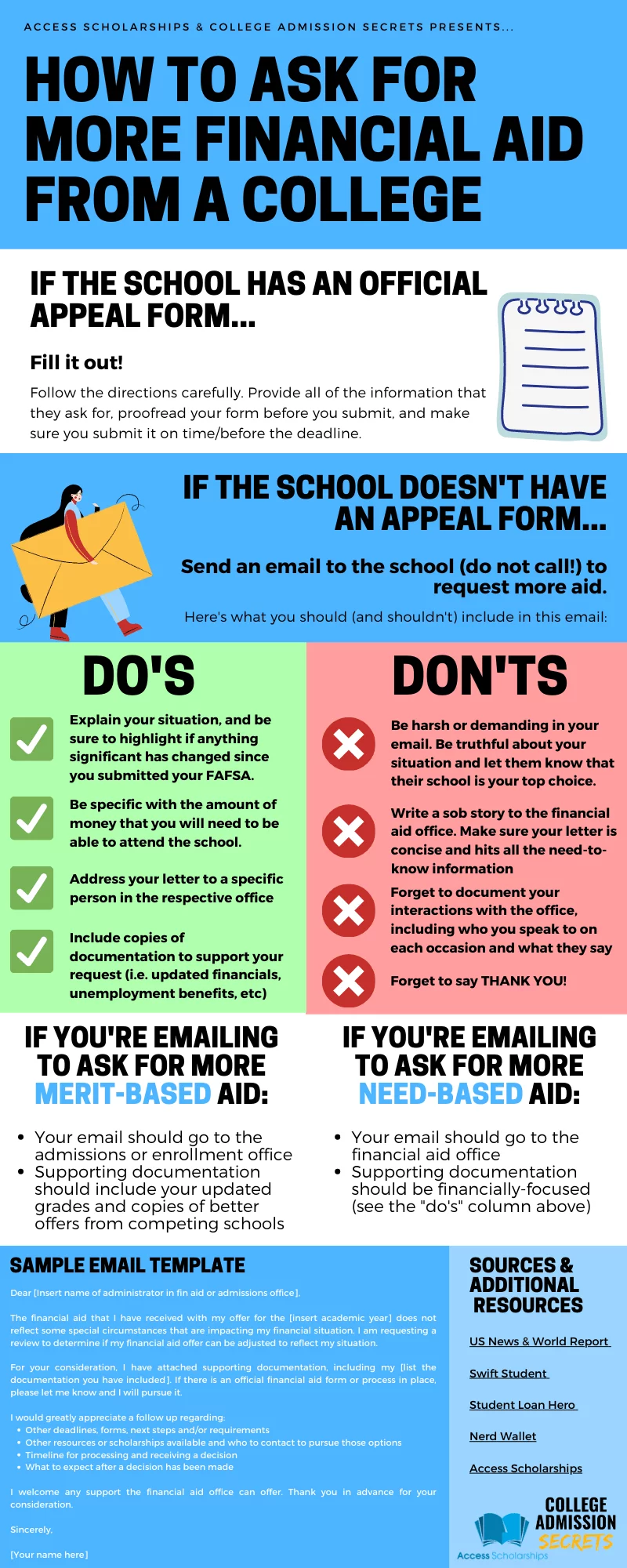
I hope this infographic guides you in the right direction when it comes to deciphering the process of asking for more financial aid!
A few things that I couldn't fit on the infographic that I think are also worth mentioning on this topic are:
Back to school szn means back to hosting virtual events!
To get the fall semester started, on September 22nd, I teamed up with the awesome people over at Admissionado (a college admissions consulting company) to put together a webinar on all things college admissions and scholarships.
Building your college list
Navigating college admissions
All things scholarships
For our first event of the year, we had an amazing turnout of nearly 150 high school students, parents, and even school counselors!
However, since not everyone was able to join in on the fun, here were some of the key takeaways:
After the virtual event, we sent out a PDF with resources to help you in your college admissions and scholarships journey. Here are some of the resources we featured:
I have big and exciting news!
Over the last few months, I have spoken to tons of you who have requested more content and student resources related to career and professional development.
As a recent college graduate who has gone through the internship and job search process on numerous occasions, I understand how difficult it can be to find reliable, up-to-date, and fun to read student resources on how to be successful in this area.
So, rather than just creating a normal blog post that might get lost in the swing of things, I decided I wanted to spice things up.
To do that, I created a student resource in the form of an eBook!
It's called "Let's Get Professional: A Student's Guide to Creating BOSS Digital Assets". My eBook is designed to walk you through every single step that you need to take in order to successfully create and/or spruce up your digital assets, with the ultimate goal being to help you become more attractive to potential employers to land those internships and jobs!
This student resource is split up into three main modules: the resume, the cover letter, and the LinkedIn profile.
Each section features the basics of how to actually create that specific digital asset, along with many personal anecdotes, do's and don'ts, links to specific resources, formatting guides, and templates, and so much more, for less than $10.

>
>
>

That's right. For the cost of just two Starbucks coffees, you can snag my eBook and all of those fabulous insights for yourself!
I know how much we all love Starbucks (or maybe you're a Dunkin fan, it's all the same in my book!), but think about the long-lasting value in 75 pages of resources, in comparison to the fleeting satisfaction of two caffeinated, albeit tasty, drinks.
As I mentioned, I was (very recently) a student myself, which means that I know how much random expenses can easily add up. If you're not sure whether or not my eBook is worth the price, just wait, because I haven't even mentioned the best part!
I know that words by themselves can be powerful, but more often than not, actually having someone there by your side to help you through the process makes it a whole lot easier.
So, by downloading Let's Get Professional, you will also receive a digital coupon to redeem a FREE 1:1 session with me to get even more help in refining your digital assets.
I believe that covers just about everything you need to know about my newest student resource release.
Ready to invest in your professional future? Click here to unlock the insights!
I promise you won't be disappointed 🙂
Sincerely,
Ayden
Ah, the good old personal statement essay. This essay, which colleges and universities often require for you to submit along with the rest of your application, is often considered a small but mighty contribution.
Unlike your SAT/ACT scores, GPA, and transcript, the college admissions essay is one of the few pieces of your application where you have the opportunity to tell your story, what makes you tick, and show why you will be a great fit on campus. When reading your essay, college admissions officers generally search to answer the following three questions:
Therefore, it is crucial to make sure that your essay checks off a few major boxes before you go and hit “submit”.
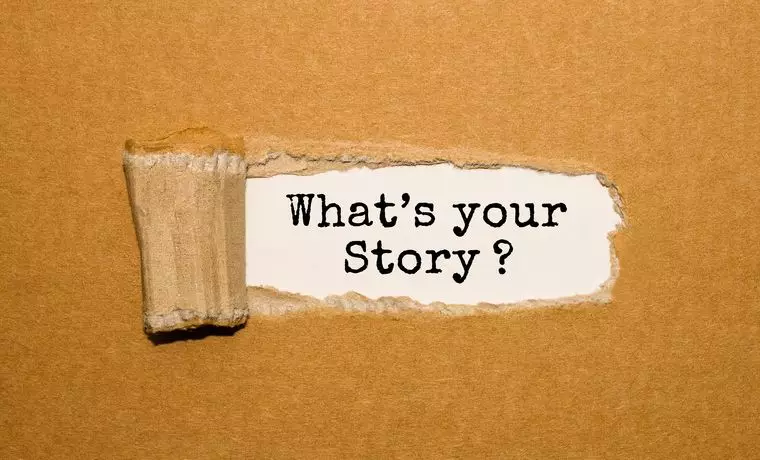
Your personal statement should…
While there is certainly never an appropriate time to bend the truth, this is even more so the case when writing your admissions essay. The whole point of the essay is that it is supposed to show admissions officers the “true you”. Officers are looking for proof that you possess the qualities of a strong and qualified applicant (think: empathy, perseverance, creativity, etc), so be sure that whatever story you tell highlights your strengths!
One common misconception about the college admissions essay is that you need to write about a HUGE time or event that completely altered your life and the entire universe. This is far from the truth! While your topic or story does not have to be about something so big, it should be something that is personally important to you. Regardless of the topic you choose to write about, you should be writing with a clear theme and message in mind that wraps your story together.
If you are writing about a certain summer job you had and how it impacted you, the one thing you should AVOID doing is plainly stating what you did and the impact it had. Be specific in telling your story, and explain the significance of the job through the details. Your goal should be to write as if you are allowing the reader to physically be in the room with you, witnessing what you went through in those moments. If you feel that this is an area you may need help with, your English teacher can likely provide some extra tips and tricks!
Because the essay is generally limited to 500 words, every single word counts! This means that you must be extremely careful to ensure that you are only including words and sentences that are relevant to telling your story. This is where it is important to differentiate between information that is crucial for the admissions officer to know (so that they can fully understand your story) and information that might be helpful to know but will not “make or break” the overall message.
Although it depends on the size of the school and how many applications are received, it is safe to say that admissions officers read A LOT of essays (think: hundreds, or even thousands!). Because of the sheer volume of essays they receive, it is your job to differentiate yourself as much as possible through your style and story from the very first sentence! Starting your essay with something along the lines of “Once upon a time…” or “Five years ago, my life changed forever” is probably not going to make you stand out. Get creative with your introduction to get your readers hooked!
This one goes along with the fact that admissions officers read so many essays each season. You want to avoid making your essay sound predictable, and you certainly don’t want your admissions officer to roll their eyes at a play on words you made that is corny or overused. Since you are trying to prove to your readers that you are going to bring a fresh and new perspective and ideas to campus, make this evident through your style.
Imagine you sit down one Saturday and decide to tackle your college admissions essay. You spend the next few days thinking about ideas, planning, writing a draft, and then you submit it. What is wrong with this picture? The answer is a lack of editing and proofreading before submission! You may spend a sufficient amount of time brainstorming and planning your essay, but that won’t matter in the end if you submit an essay full of spelling or grammar mistakes. Therefore, it is important to make yourself a checklist before you get writing so that you don’t forget to spend an ample amount of time planning, editing, and proofreading your essay before you submit it.
Now that we have covered the essentials of what your college admissions essay SHOULD include, let’s touch on a few important and common questions that students tend to ask.
The answer is, it depends! Some prompts might specify that your essay should be “at least” 500 words, while others may say something like “In 500 words, tell us a story about a time when…”. The general rule of thumb is that if the prompt says something like “at least” or “no more than” 500 words, be sure to adhere to those borders. However, if the prompt does not specify, then you should aim to be as close to 500 as possible, but don’t worry about hitting it exactly on the dot.
Students tend to get the idea that your personal statement essay must be the most professional-sounding and seriously written piece of work in their repertoire. This is not the case! While it should sound polished and it should definitely be edited and proofread, the tone of your essay can be whatever you feel like will get the message across the best. After all, you want admissions officers to hear your voice through your writing.
While it would certainly be to your benefit to write about something that is unique to you, if nothing terribly unique comes to mind in your brainstorming, consider writing about a pivotal event or experience in your life, but doing so with a unique or uncommon approach.
While the 500-word essay, or personal statement, may seem daunting, it certainly does not have to be if you save yourself an adequate amount of time to brainstorm, draft, write, edit and proofread before submitting. Ultimately, your essay should be 100% unique to you, and it should help admissions officers gain a better idea of what kind of person you are and what you bring to the table. Therefore, your essay should sound like it is written by YOU, and not by a robot or third source. Remember that while there is no “correct” structure, format, or tone that you must write your essay in, at the end of the day, it should tell a true and engaging story that shows your personality and who you are. Now that you have the tools and knowledge to write a killer 500-word essay, happy writing!
(Bonus resource: If you are looking for some inspiration to get your creative juices flowing, check out these 26 Outstanding College Essays!)
If you liked this post, check out these other articles related to college:
How to Get Involved in College
10 Extracurricular Activities that Look Great on College Applications
I have spoken to a LOT of students (mostly through Instagram, but also through my office hours sessions) who have requested I post more information and resources for those of you who want to study in the US.
So, if you're a student currently living in a country other than the United States, and you are considering (or already planning on) coming here to pursue your higher education degree (whether it's undergrad or grad), you've come to the right place.
FULL DISCLAIMER: As someone who attended college in the US as a US citizen and non-international student, I am definitely no certified guru on all of the ins and outs of what goes into this process.
However, I have been doing a fair bit of research on this over the last few weeks per your requests, so now I want to share the wealth of my findings with you here!
Without further ado, below, I will outline the general process of everything you need to know in order to prepare to and successfully study in the US.
First things first, you're going to want to start by doing some research on the schools that you might be interested in attending. If you are interested in coming to the US for your undergraduate degree, it is recommended that you start this process anywhere between 12 and 18 months prior to when you would start your first semester.
You'll want to start the process by making sure that the schools you are looking at are certified by the Student Exchange Visitor Program (SEVP). You can do this by heading to this school search.
Luckily, there are literally thousands of schools on this list, so I am positive that you will have no problem shortlisting at least a few after you've narrowed down your criteria.
Speaking of narrowing down your criteria, if you want to make this process as seamless as possible, you'll likely want to answer a few of these questions below to help you get started and pick some schools:
*Why do I want to study in the US?
1) what type of program am I interested in?
2) will I need financial assistance, and if so, how much?
3) what are the specific deadlines for the schools I am interested in?
4) is there any specific area of the country that I want to study in?
5) what type of school do I want to attend (for example, a large public university or a small private college, a city school, or a rural campus?)
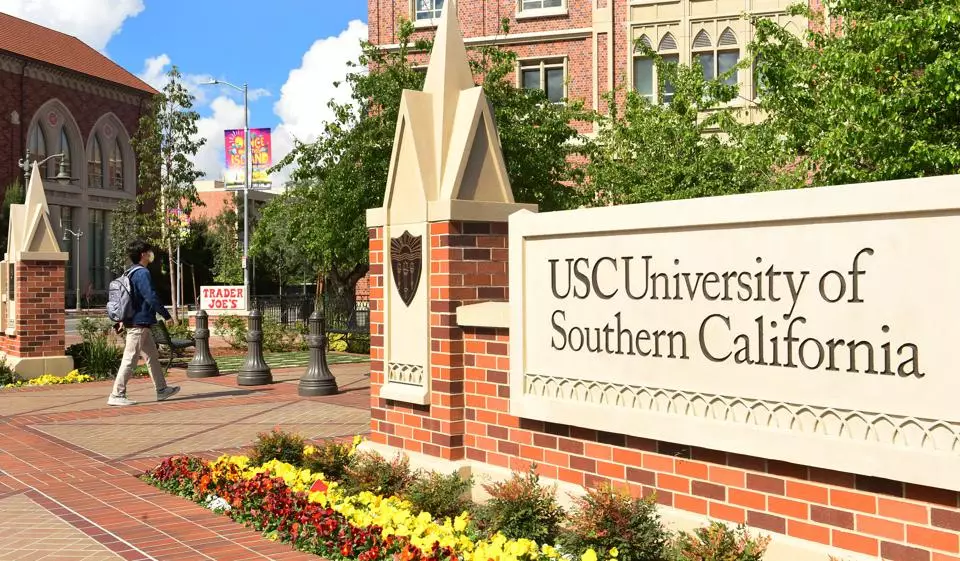
After you've answered hopefully all of these questions, you can look to the next step, which is focusing on how you are going to finance your degree.
Your education, like a lot of other things, is an investment in your future, so it is of the utmost importance that you spend a considerable amount of time assessing your options financially and factoring cost into the equation as you think about what schools you're interested in.
It's no secret that studying in the US can be expensive. However, it doesn't necessarily have to be. Location is one thing you will definitely want to keep in mind here. Certain schools are notably more expensive than others because they are located in areas with a high cost of living.
If you know that you are on a budget, consider focusing your research on public universities (they tend to be less expensive than private schools) that are located in more suburban or rural areas, as opposed to bustling cities.

Also on the topic of finances, as an international student looking to study in the US, you, unfortunately, cannot apply for the FAFSA or federal aid. However, lots of US colleges and universities offer generous scholarships and tuition opportunities to international students.
This great resource allows you to search through these opportunities and offerings based on degree level, US state, and location. I suggest you use this tool to look up the opportunities that all of the schools you are interested in have to offer.
PS - the easiest way to keep track of all of this information is definitely through a spreadsheet. I definitely recommend creating one where you can keep track of all the financial information you find about the schools you want to apply to, so you can eventually compare!
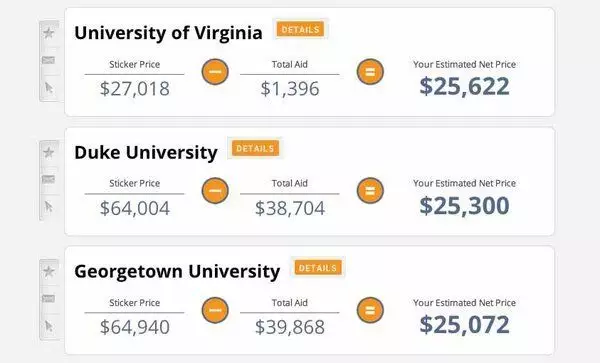
Now that we've gotten some of the finance stuff out of the way, we can focus more on the actual admissions process.
Since the majority of you who have reached out to me have been high school students (juniors and seniors) asking specifically about undergraduate degrees, I'm going to walk you through some key pieces of the undergraduate admissions process, highlighted directly from the EducationUSA website:
One thing I additionally want to note is that each US college and university has its own specific set of application requirements, so be sure to check on each school's website to make sure you have everything you need to apply!

Once you have gone through the admissions process and you have been accepted to the school(s) you applied to, you can look into the next step, which is applying for your visa.
Along with your acceptance to a school, you will receive what's called a Form I-20, or "Certificate of Eligibility for Nonimmigrant Student Status". After you receive this form, you then must pay a fee (called an I-901 SEVIS Fee) so that you can be issued a visa. If you do not pay this fee, you cannot go through the visa process, so make sure you pay it!
The proper visa for students coming to study in the US through an undergraduate program is the F-1 visa. This page highlights everything else you will need to guide you through the visa application process.
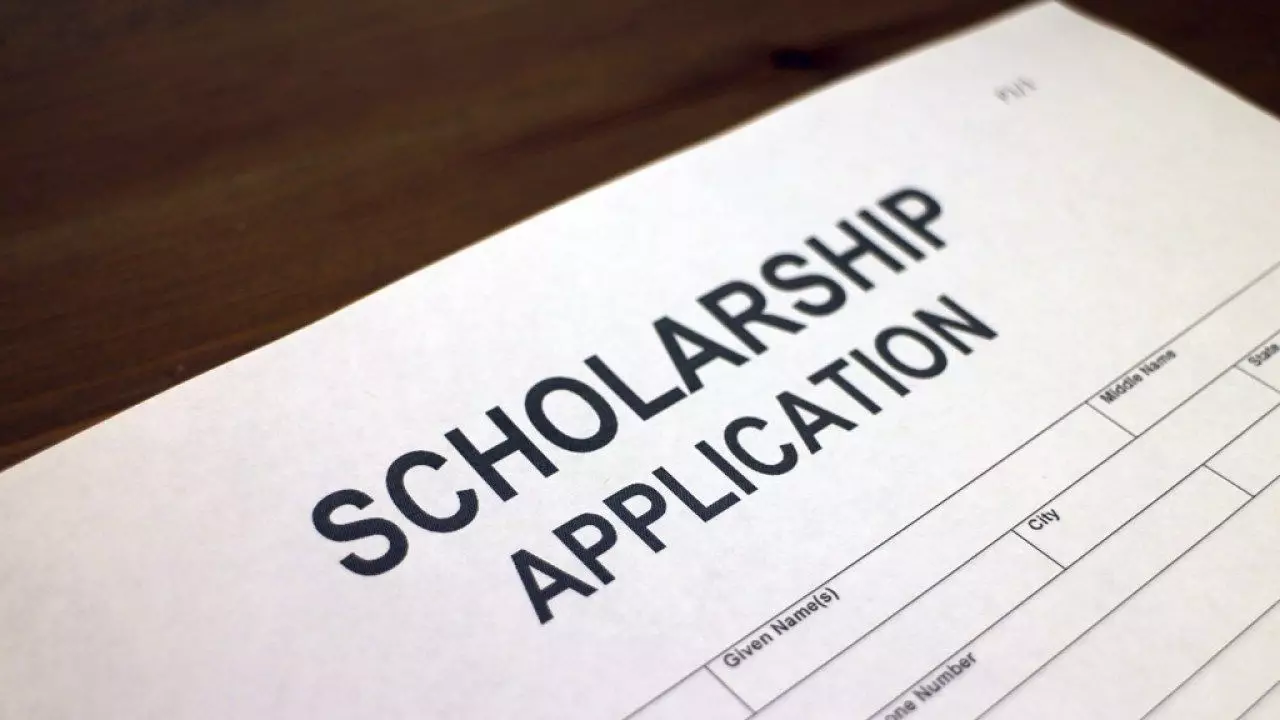
Once your visa is fully processed, you can continue to prepare (mentally, emotionally, AND financially) to head over to study in the US! Speaking of financial preparation...
Hopefully whatever school you end up deciding to enroll in has some decent scholarship and financial aid opportunities to help you fund your education. Some schools even offer scholarships that are close to a full-ride for the highest-achieving international students!
But, I would be remiss to leave out the importance of applying for outside (private organization) scholarships from this post!
These types of scholarships (merit-based, no-essay, and more) can be a great way to help supplement any of the aid that you receive from your school itself.
If you're not sure where to get started with applying for these types of scholarships, I recommend you start by heading over to my blog post on Scholarships for International Students.
After that, take a look through my database of scholarships to find other opportunities that you might be a good fit for.
So with that, I think I have covered pretty much everything there is to know (on a somewhat high level) about studying in the US. Happy researching, applying, and attending!
The COVID-19 pandemic has successfully inserted itself into essentially every aspect of our lives at this point, and unfortunately, it has mostly not been for the better, although any optimist will likely be quick to highlight those few gold nuggets and silver linings.
One particular area of the population that has been struggling to navigate these turbulent times is the area containing prospective, current, and recently graduated college students. With the costs of higher education only on the rise and the rough circumstances of the pandemic leaving millions of people jobless or furloughed until further notice, families are struggling to come up with the funds to pay for or pay off college-related expenses.
Enter all the news on newly-elected president Joe Biden’s plans and proposals to both provide some much-needed relief to those being weighed down by the burden of thousands in student loans while also lowering the costs of tuition for many current and future college students.
In this post, I will highlight several areas of Biden’s currently enacted and proposed plans as they relate to student loans, college tuition, and higher education in general. Keep reading for the tea!
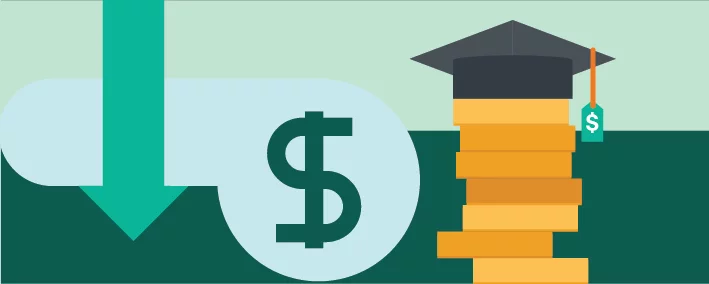
During his first day in office, President Joe Biden made the move of extending student loan payment forbearance to September 30, 2021, a decision made primarily due to the pandemic and its detrimental impact on millions of Americans.
Essentially, this means that the majority of federal student loan payments are on pause, and any new interest on loan balances will be waived.

In addition to this push back on the date, Biden and his team are also pushing for an immediate canceling of $10,000 of student loan debt for all, a move which would “wipe out debt completely for nearly 15 million borrowers who owe $10,000 or less” (Nerd Wallet).
Along with the immediate $10,000 cancellation, Biden has also recommended that federal student debt should be completely canceled for borrowers who attended a public college or university and currently earn less than $125,000.
One important thing to note about this recommendation is that it does not apply to graduate school tuition.

Essentially, Biden’s revised plan proposes that borrowers would not have to start paying back their loans until they earn an annual income of over $25,000.
Once borrowers earn over this number, their repayment plan would then cap at 5% of disposable income, a much more reasonable number than the current options, in which the minimum is set at 10% of disposable income.
Not only is Biden proposing to make monthly student loan payments more reasonable, but he is also pushing to make it so the remainder of your student loan balance will be automatically forgiven after 20 years of payments.
This is in comparison to current repayment plans, which offer forgiveness after 20-25 years of payments.
Students whose family incomes are less than $60,000 per year are eligible for either some or all of a Federal Pell Grant, which is currently worth $6,345.
While this is a great help, it still leaves quite a bit of tuition and expenses on the table for the majority of students attending four-year colleges.
Biden hopes to increase this number while simultaneously loosening the eligibility rules so that Pell Grants can be given out to more “middle-class” students.
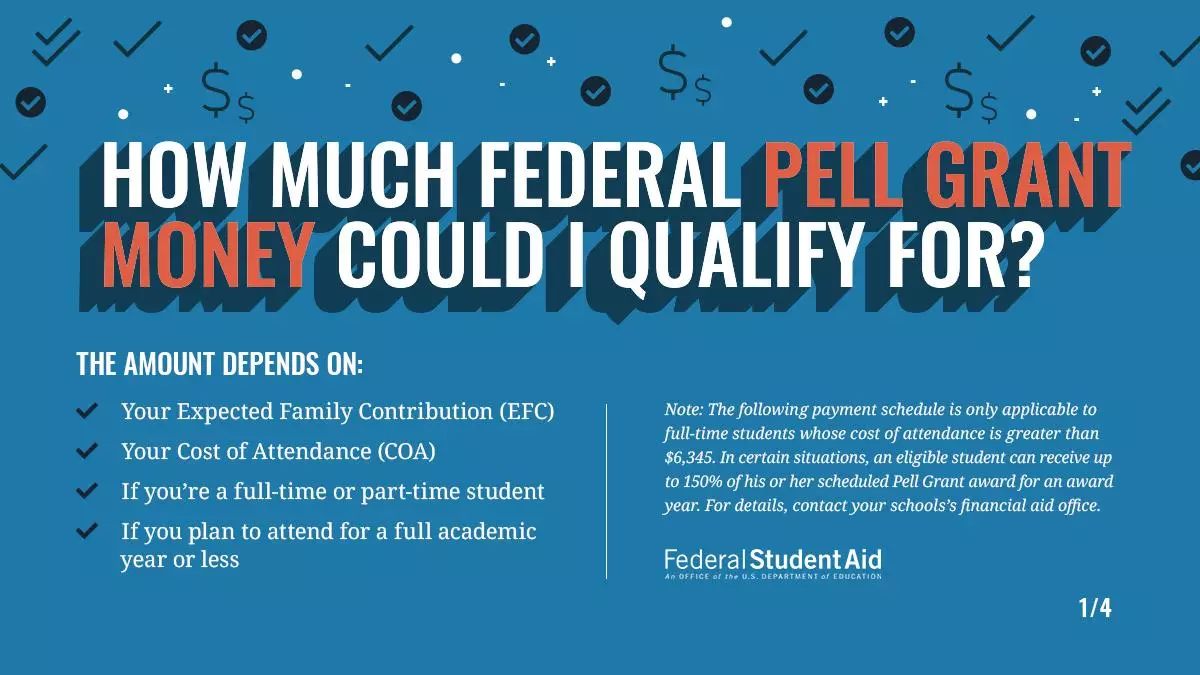
Perhaps the most noteworthy part of Biden’s plan is his proposal to make undergraduate tuition-free for students who fall into the following areas:
1) if you attend a public college or university and your family income is below $125,000 (4 years tuition-free)
2) if you attend a community college (2 years tuition-free), and
3) if you attend an HBCU or a tribal college or university (2 years tuition-free).
Students should note that these free college tuition plans do not include non-tuition expenses such as room and board, textbooks, and other fees.

So, I’ve covered quite a bit of information regarding Biden’s current and potential future plans of action as they relate to student loans and college tuition.
I’d be remiss to end this post without quickly elaborating on exactly how these current and future plans can actually impact you! Here’s the lowdown…
If you are a college graduate and you have debt - congrats! Well, not about the debt, but because Biden’s extension of student loan payment forbearance means that if you are not currently in the position to be paying off your student loans, then you can put that worry on the back burner for a few more months.
Lots of people have been asking questions along the lines of “If I am still in a position to be paying off some of my student loans during these difficult times, should I be doing so?”.
Since I am very admittedly no financial expert, here is a little nugget of advice that I found while perusing Student Aid’s section on Student Loan Payment Forbearance:
“Continuing to make payments during the payment suspension could help you pay down your loan balance more quickly because the full amount of a payment will be applied to principal once all interest accrued prior to March 13, 2020, is paid.
You may either leave your loans in the “administrative forbearance” status (meaning the requirement to make payments is suspended) and make payments anyway, or opt out of the administrative forbearance/suspension of payments and continue to make payments.”
- (Studentaid.gov)
If you’re looking for a more in-depth answer, I highly suggest clicking the hyperlink above and reading through all of the Q & A’s on COVID Forbearance and how it all works. If you have any other questions that Student Aid has not covered, be sure to reach out to your specific student loan servicing company to get those clarified.
If you are a current college student - Now, if you are still enrolled as an undergraduate student at a college or university, unfortunately, Biden’s current plans and hopeful proposals in relation to paying off student loans don’t quite impact you just yet.
Usually, you are not required to start paying off student loans until an average of 6 months after you have actually graduated, so even if you’re a college senior graduating this May, Biden’s extension likely won’t impact you too much either, unless it gets extended again of course!
If you are a future college student - Pay close attention to the latest news and updates on Biden’s plans to hopefully expand the eligibility rules for students qualifying for federal Pell Grants as well as information on actually transitioning to making college tuition-free for students under certain circumstances.
So, quite a bit of information has been unpacked here! At the end of the day, it is crucial to ensure that you are keeping up to date with these plans (both ones that are in effect and future ones) and how they might impact you, on an immediate level but also for months and years to come.